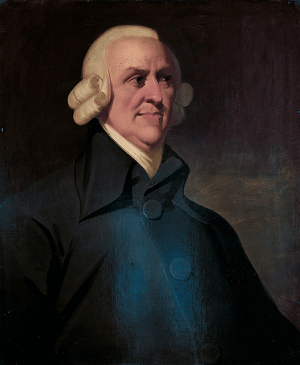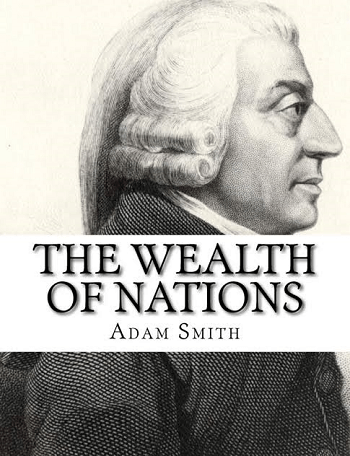Who Was Adam Smith?Adam Smith, a Scottish economist, philosopher, and novelist who lived in the 18th century, is regarded as the founder of modern economics. Smith was a strong major proponent of laissez-faire economic principles and opposed mercantilism. Smith introduced the concept of an invisible hand-the propensity of free markets to govern themselves via competitiveness, supply and demand, and self-interest-in his first work, The Theory of Moral Sentiments. 
Smith is also credited with developing the idea of the gross domestic product (GDP) and his theory of how to offset pay disparities. This hypothesis holds that risky or unappealing professions typically pay more to entice employees to these positions. An Inquiry into the Nature and Causes of the Wealth of Nations, written by Adam Smith in 1776, are two of his most significant contributions to the study of economics. Smith mastered social philosophy while attending the Universities of Glasgow and Oxford's Balliol College. He was one of the first recipients of scholarships offered by colleague Scot John Snell. He collaborated with David Hume during the Scottish Enlightenment after graduating from the University of Edinburgh and delivering a series of well-received public lectures there. The Theory of Moral Sentiments was written and published by Smith, a professor of moral philosophy at Glasgow. Later in life, he accepted a tutoring career that permitted him to travel around Europe and connect with many people. Early Life
Smith's life is observed through writing at his baptism on June 5, 1723, at Kirkcaldy, Scotland. Although his precise birthdate is uncertain, he was raised and supported by his mother, Margaret Douglas, following the passing of his father, Adam Smith (date unknown). At the age of 13, he enrolled at the University of Glasgow. Later, he went to Balliol College at Oxford University to study European literature. After a succession of well-received lectures that he gave at Glasgow University and returned home, the university named him the chair of logic in 1751 and the chair of moral philosophy in 1752. Smith gave several open talks at the University of Edinburgh after leaving Scotland. His lecture series was a success, and in 1751, Glasgow University appointed him as a professor. He ultimately became the Chair of Moral Philosophy. Smith sought to publish certain lectures throughout his years of working and teaching at Glasgow. The Theory of Moral Sentiments, his treatise, was ultimately released in 1759. To take a more lucrative job as a personal tutor to Charles Townshend's stepson, a future Chancellor of the Exchequer and amateur economist, Smith, relocated to France in 1763. Smith lived in France simultaneously with Benjamin Franklin, David Hume, and Voltaire, all of whom were intellectuals. Notable Accomplishments: The Wealth of the Nations
Smith worked to publish some of his lectures during the years he spent working and teaching in Glasgow. His book, the Theory of Moral Sentiments, was eventually released in 1759. After coming from France and moving to his hometown of Kirkcaldy, Scotland, Smith wrote his most significant work, An Inquiry into the Nature and Causes of the Wealth of Nations (commonly referred to as "The Wealth of Nations"), which was published in 1776. Smith's book discussed many of the concepts that are cornerstones of classical economics and are more widely accepted. On the foundation of Smith's work, other economists strengthened classical economic theory, which remained the preeminent school of economic thought throughout the Great Depression. Smith's work covers the transformation of human civilization from a hunter-gatherer phase without property ownership or fixed residences to a nomadic agricultural stage with shifting residences. The next phase is a feudal system where laws and property rights protect privileged classes. Last but not least, free markets or laissez-faire characterize contemporary society, where new organizations are created to carry out market transactions. The concept of the "economic man", characterized as a person who pursues self-interested objectives and interests, is addressed in Smith's work. The Philosophy of Free MarketsThe theory of free markets strongly emphasizes limiting the influence of taxation and government intervention in the market. Smith supported a small government but believed that the government should be in charge of a nation's defense and education systems. The "Invisible hand" theory, which governs the dynamics of supply and demand in an economy, is a concept that Smith provided during his days. According to this notion, everyone unintentionally contributes to the best outcome for everyone by watching out for themselves, making a wealthy nation. In such an economy, a fictitious baker, brewer, and butcher would expect to profit from selling goods that customers would have wanted to purchase. Also, they may reap financial benefits if they successfully address the demands of their clients. While they are operating their business to make money, they also offer goods that consumers demand. According to Smith, such a system generates income for the butcher, brewers, baker, and the entire country. The Invisible Hand Theory
According to Smith's thoughts and theories, a prosperous society is filled with inhabitants who labor effectively to better themselves and meet their financial demands. According to Smith, in this type of economy, a man would put his money into the business with the best chance of giving him the biggest return for a particular amount of risk. The invisible-hand idea is frequently presented as a natural phenomenon that, via producers and consumers and competition for limited resources, steers capitalism and free markets toward efficiency rather than as something that promotes the happiness of individuals. According to Smith, an organizational structure is required to guide persons toward constructive endeavors that benefit society. This framework is made up of organizations like the legal system and serves to safeguard and advance free and fair competition. On the other hand, for Smith, competition is the "want that comes with us from birth and never leaves us until we walk into the grave," and there must be support for this kind of framework. Wealth and Production of GoodsThe Wealth of Nations' concepts attracted attention on a global scale. They catalyzed the transition from wealth based on lands to the wealth produced by assembly-line manufacturing techniques made feasible by the division of labor. Smith used the labor-intensive process of making a pin as an example to demonstrate the viability of this approach. One individual could only produce a small number of pins each week if he went through all 18 steps to do the assignment. However, the output would increase to thousands of pins every week if the 18 activities/ steps were carried out in an assembly-line way by ten people. Smith said that the expertise brought by the addition of labor leads to wealth. Gross Domestic Product (GDP)
The concepts presented in The Wealth of Nations revolutionized the import and export industries and served as the basis for the gross domestic product (GDP). The value of a nation's gold and silver reserves was used to determine a nation's worth before the publication of The Wealth of Nations. On the other hand, Smith was a fierce opponent of mercantilism and believed that nations should be ranked according to their levels of commerce and productivity. This was the foundation for developing the GDP statistic for assessing a country's prosperity. Many nations were reluctant to do commerce when The Wealth of Nations was first published. Smith believed that a free market should be established since it benefits both nations. There was a rise in imports and exports due to this shift in trade views. Smith also promoted laws and aimed at facilitating commerce as much as possible. LegacyThe "invisible hand" and the division of labor, two of Adam Smith's most famous concepts, are now accepted economic tenets. In contemporary economic theory, his economic views are still relevant in the twenty-first century. Smith supported the idea that the labor of the underprivileged is a crucial indicator of how well an economy is doing. Still, he was also recognized for being concerned about inequality in general. The Wealth of Nations was a major source of inspiration for Karl Marx, a political economist and social philosopher who expanded on Adam Smith's works considerably. Marx, on the other hand, thought that capitalism resulted in citizen greed and inequality and would finally lead to its collapse. In contrast, Smith thought capitalism was the best system for economic expansion. Classical economists provided rival hypotheses to Smith's ideas and dubbed the "labor theory of value". Smith's labor ideas were also utilized in later Marxian economics that descended from classical economics. Das Kapital, Karl Marx's seminal work, was originally launched in German in 1867. Marx's main points were on the capitalist mode of production and what he saw as exploiting workers by capital. According to the labor theory of value, a thing's worth is defined by the amount of labor that goes into producing it. One may contrast this with the current claim of neoclassical economics, which holds that a thing's worth is defined by what one is willing to sacrifice to get it. From around 1870 to 1910, a corpus of ideas now known as "neoclassical economics" or "marginalism" developed. Neoclassical economists like Alfred Marshall helped popularise the term "economics" as a shorthand for "economic science" and a replacement for Adam Smith's previous, more general phrase "political economy". This was consistent with the effect on the subject of mathematical techniques used in the natural sciences. Supply and demand were systematized in neoclassical economics as common factors determining price and quantity in market equilibrium, impacting production and income distribution allocation. The marginal productivity concept of value on the consumer side and a more comprehensive theory of expenses on the supply side replaced the labor theory of value, with which Smith was most notably associated with classical economics. The terminology "free-market economics" or "free-market economist", according to economist Daniel Klein, is too generic and slightly deceptive when used to describe Adam Smith's theories. To more accurately describe the "Smithian" identity, Klein proposed six characteristics essential to Smith's economic thought authenticity. Some of the misconceptions regarding Adam Smith's views on the free market were clarified by economist David Ricardo. Even though Smith was not a free-market economist, most people continued to believe this. Smith was in favor of assisting budding industries, as Ricardo emphasized. Because Adam Smith recognized that wealth is generated through work and that individuals use their resources to make money out of self-interest, his writings continue to influence economics today. Smith's beliefs, according to which a free market, capitalism, and competition jointly promote economic growth, are still relevant in the twenty-first century. Honors and Awards
Smith's picture appeared on the £20 note in 2007, thanks to the Bank of England. He was a member of the Royal Society of Arts, and various Scottish structures bear his name. The highest accolade granted by The Association of Private Enterprise Education is the Adam Smith Award, which also bears his (Smith) name. His name holds a chair, library, building, and even an entire research center at the University of Glasgow. |
 For Videos Join Our Youtube Channel: Join Now
For Videos Join Our Youtube Channel: Join Now
Feedback
- Send your Feedback to [email protected]
Help Others, Please Share










